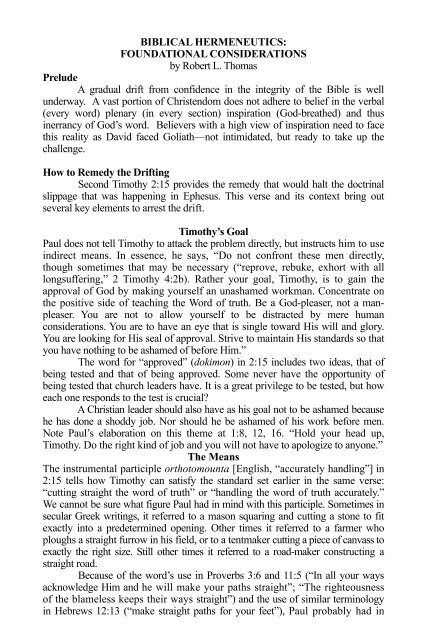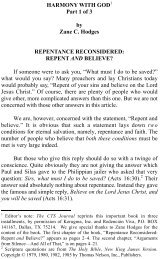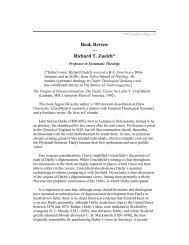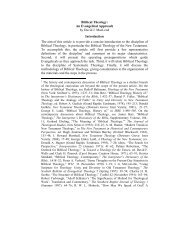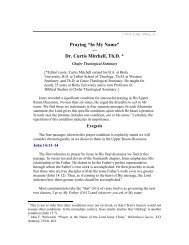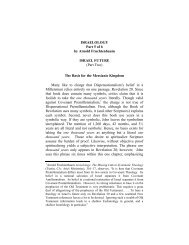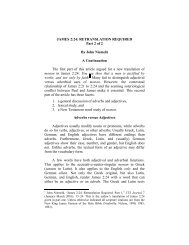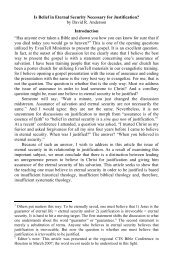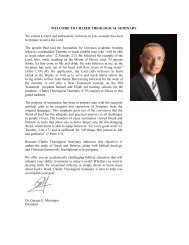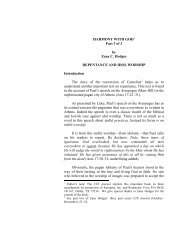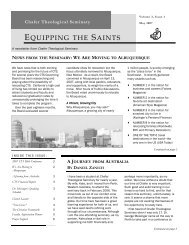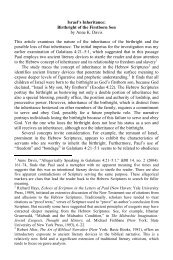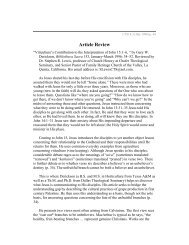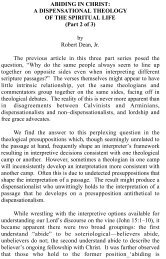BIBLICAL HERMENEUTICS - Chafer Theological Seminary
BIBLICAL HERMENEUTICS - Chafer Theological Seminary
BIBLICAL HERMENEUTICS - Chafer Theological Seminary
You also want an ePaper? Increase the reach of your titles
YUMPU automatically turns print PDFs into web optimized ePapers that Google loves.
<strong>BIBLICAL</strong> <strong>HERMENEUTICS</strong>:<br />
FOUNDATIONAL CONSIDERATIONS<br />
by Robert L. Thomas<br />
Prelude<br />
A gradual drift from confidence in the integrity of the Bible is well<br />
underway. A vast portion of Christendom does not adhere to belief in the verbal<br />
(every word) plenary (in every section) inspiration (God-breathed) and thus<br />
inerrancy of God’s word. Believers with a high view of inspiration need to face<br />
this reality as David faced Goliath—not intimidated, but ready to take up the<br />
challenge.<br />
How to Remedy the Drifting<br />
Second Timothy 2:15 provides the remedy that would halt the doctrinal<br />
slippage that was happening in Ephesus. This verse and its context bring out<br />
several key elements to arrest the drift.<br />
Timothy’s Goal<br />
Paul does not tell Timothy to attack the problem directly, but instructs him to use<br />
indirect means. In essence, he says, “Do not confront these men directly,<br />
though sometimes that may be necessary (“reprove, rebuke, exhort with all<br />
longsuffering,” 2 Timothy 4:2b). Rather your goal, Timothy, is to gain the<br />
approval of God by making yourself an unashamed workman. Concentrate on<br />
the positive side of teaching the Word of truth. Be a God-pleaser, not a manpleaser.<br />
You are not to allow yourself to be distracted by mere human<br />
considerations. You are to have an eye that is single toward His will and glory.<br />
You are looking for His seal of approval. Strive to maintain His standards so that<br />
you have nothing to be ashamed of before Him.”<br />
The word for “approved” (dokimon) in 2:15 includes two ideas, that of<br />
being tested and that of being approved. Some never have the opportunity of<br />
being tested that church leaders have. It is a great privilege to be tested, but how<br />
each one responds to the test is crucial?<br />
A Christian leader should also have as his goal not to be ashamed because<br />
he has done a shoddy job. Nor should he be ashamed of his work before men.<br />
Note Paul’s elaboration on this theme at 1:8, 12, 16. “Hold your head up,<br />
Timothy. Do the right kind of job and you will not have to apologize to anyone.”<br />
The Means<br />
The instrumental participle orthotomounta [English, “accurately handling”] in<br />
2:15 tells how Timothy can satisfy the standard set earlier in the same verse:<br />
“cutting straight the word of truth” or “handling the word of truth accurately.”<br />
We cannot be sure what figure Paul had in mind with this participle. Sometimes in<br />
secular Greek writings, it referred to a mason squaring and cutting a stone to fit<br />
exactly into a predetermined opening. Other times it referred to a farmer who<br />
ploughs a straight furrow in his field, or to a tentmaker cutting a piece of canvass to<br />
exactly the right size. Still other times it referred to a road-maker constructing a<br />
straight road.<br />
Because of the word’s use in Proverbs 3:6 and 11:5 (“In all your ways<br />
acknowledge Him and he will make your paths straight”; “The righteousness<br />
of the blameless keeps their ways straight”) and the use of similar terminology<br />
in Hebrews 12:13 (“make straight paths for your feet”), Paul probably had in
CTS Journal 12 (Fall 2006)<br />
mind the figure of road construction. The specifications for the construction 2<br />
have to be exactly right.<br />
Some have objected to trying to understand just what figure Paul had in<br />
mind. They say that what we need to do is to be in the same ballpark with our<br />
interpretation. They claim that knowing the broad sense of the Word is<br />
sufficient, and pressing to figure out the specific meaning is an example of<br />
logomachia (“striving with words,” “hair splitting,” 2 Timothy 2:14) that Paul<br />
forbids in the verse just before 2:15. That is not, however, what Paul meant by<br />
logomachia.<br />
In 1 Timothy 6:4 the word refers to quibbling over words, so here he<br />
probably refers to verbal disputes that distract from the close attention that<br />
should be given the word of truth. “Truth” highlights the contrast between God’s<br />
unshakable special revelation and the worthless chatter of the novelty seekers in<br />
Ephesus. A correlation exists between the quality of a detailed analysis of Scripture<br />
and maintaining doctrinal orthodoxy.<br />
In 2:15 the command instills in Timothy’s mind the importance of<br />
precision. Learning the general idea of what Scripture teaches is not sufficient<br />
because it gives the novelty teachers too much room to roam in justifying their<br />
innovations. It allows them to shade the truth a little bit this way or that way in<br />
order to integrate the Bible with psychology, science, philosophy, anthropology,<br />
sociology, mathematics, modern linguistics, or some other secular discipline that<br />
allegedly has come up with additional truth from God’s general revelation. An<br />
expositor’s handling of Scripture has to be accurate. It has to be right on target.<br />
General Introduction<br />
The topic of this article will take us through an assortment of general<br />
considerations related to biblical hermeneutics. The first thing to do is to review the<br />
role of hermeneutics in relation to other subjects in the theological curriculum. In<br />
view of limited space, the review comes most easily in viewing a chart (see chart<br />
#1, next page).<br />
Clarifying the Definition<br />
With the traditional grammatical-historical approach to exegesis, three areas<br />
of study constitute the foundational approach to obtaining the meaning of a biblical<br />
text, if meaning is what you are seeking from a biblical text.<br />
At this point we must inject a parenthesis into our discussion because of<br />
recent confusion that has been injected into the discussion of biblical<br />
interpretation. Recent definitions of key terms have varied from traditional<br />
senses of the words, making it necessary for us to recapture and emphasize the<br />
original sense. Four varying definitions of hermeneutics have in recent years<br />
been espoused, 1 but the correct definition is “a set of principles.” Of the four<br />
recently suggested meanings for exegesis, only “an implementation of valid<br />
interpretive principles” is correct. Recent proposals have listed as many as<br />
eight definitions of meaning, but only “the truth intention of the author”<br />
1<br />
For a listing and a discussion of newly proposed definitions of various terms, see Robert<br />
L. Thomas, Evangelical Hermeneutics: The New Versus the Old (Grand Rapids: Kregel,<br />
2002), 20-27.
Open Letter<br />
satisfies time-honored standards. The only one of four proposed definitions of 3<br />
interpretation that measures up to long-standing criteria is “an understanding of<br />
the truth intention of the author.”<br />
Schema of Relationships<br />
Between Fields of <strong>Theological</strong> Study - #1<br />
Level 4<br />
Bible Exposition<br />
Level 3<br />
Systematic &<br />
Biblical<br />
Theology<br />
Church<br />
History &<br />
Historical<br />
Theology<br />
Philosophy of<br />
Religion &<br />
Apologetics<br />
Counseling<br />
Christian Ed.<br />
Administration<br />
Homiletics<br />
Etc.<br />
Level 2<br />
Biblical Exegesis<br />
Level 1<br />
Biblical<br />
Introduction<br />
Hermeneutics<br />
Biblical<br />
Languages<br />
The proliferation of ramifications now attached to hermeneutical<br />
terminology is bewildering. No one intentionally created this state of confusion,<br />
but it is a shame that propounders of the new hermeneutical approaches did not<br />
utilize new terms for different meanings rather than assigning new meanings to old<br />
terms. It is almost as if there is an unconscious desire to retain a continuity with<br />
the past where little or no continuity exists. The practice of assigning new<br />
meanings to old words has resulted in an unusually high degree of uncertainty in<br />
communication among evangelicals. To what does one attribute such confusion?<br />
Final answers to that question are evasive, but a proposal is that confusion<br />
in defining common hermeneutical terms has arisen at least in part from different<br />
hermeneutical principles that have come into play among evangelicals in recent<br />
years.
CTS Journal 12 (Fall 2006)<br />
4<br />
The Foundational Nature of Hermeneutics<br />
Chart #1 (above) shows the foundational role of hermeneutics,<br />
traditionally referred to as grammatical-historical principles. The grammar<br />
requires a knowledge of the principles of the biblical languages—Hebrew,<br />
Aramaic, and Greek. The history necessitates an awareness of the facts of<br />
history. Obviously, to utilize the principles of hermeneutics, a person must<br />
have a working knowledge of the original languages of the text of Scripture. He<br />
must know what books belong in the canon and must establish the exact text of<br />
the autographs of the books of the Bible. He gets help here from that portion of<br />
Biblical Introduction known as General Introduction with the area of Special<br />
Introduction furnishing him an understanding of the history surrounding the<br />
writing of each book.<br />
Even here, however, confusion has arisen in the disciplines that stand<br />
beside hermeneutics at Level 1 as foundational to the practice of exegesis, which<br />
is at Level 2 in the <strong>Theological</strong> Curriculum. For one thing, traditional<br />
grammatical principles have come under assault by a relatively new discipline<br />
frequently referred to as Modern Linguistics. Modern Linguistics, though it still<br />
in a fluid stage of development, has challenged principles of grammar that have<br />
been a hinge and staple of grammar of long standing. Daniel Wallace’s wellknown<br />
Greek Grammar Beyond the Basics is full of the influence of Modern<br />
Linguistic principles that have strayed away from a centuries-old understanding<br />
of grammatical principles. A typical example of this is his “plenary genitive” in<br />
which he not only allows for but also advocates more than a single meaning for a<br />
specific grammatical construction. 2<br />
The English word “historical” has several meanings. It can be either<br />
history as a record of actual happenings simultaneous with the chronology of<br />
the narrative or history as interpreted by later chronological generations.<br />
Grammatical-historical principles have traditionally looked to the former of these<br />
definitions, but some evangelicals today are veering away from that meaning and<br />
opting for the dynamic concept of history. Progressive Dispensationalism is an<br />
example of the dynamic concept—i.e., an ongoing record of past events—versus<br />
a stable concept [past events connected with someone or some event]. 3<br />
In light of such deviations from traditional definitions of various terms,<br />
when one speaks of following grammatical-historical principles of interpretation,<br />
he must be careful to define clearly his what he means. Otherwise, his<br />
hermeneutical principles may be indistinguishable from those used by the new<br />
evangelical hermeneutics.<br />
2<br />
E.g., D. B. Wallace, Greek Grammar Beyond the Basics: An Exegetical Syntax of the New<br />
Testament (Grand Rapids: Zondervan, 1996), 119-21.<br />
3<br />
E.g., Darrell L. Bock, “The Words of Jesus in the Gospels: Live, Jive, or Memorex?” in<br />
Jesus under Fire, eds. Michael J. Wilkins and J. P. Moreland (Grand Rapids: Zondervan,<br />
1995), 81-84.
Open Letter<br />
Recent Additions to the Foundation<br />
5<br />
Evangelical hermeneutics as now practiced in many and probably most<br />
evangelical environments takes on a different complexion from the traditional<br />
evangelical model. Level 1 in the Schema of Relationships Between Fields of<br />
<strong>Theological</strong> Study has a new member. We may chart the resulting new<br />
Schema as in chart #2:<br />
Schema of Relationships<br />
Between Fields of <strong>Theological</strong> Study - #2<br />
Level 4<br />
Bible Exposition<br />
Level 3<br />
Systematic &<br />
Biblical<br />
Theology<br />
Church<br />
History &<br />
Historical<br />
Theology<br />
Philosophy of<br />
Religion &<br />
Apologetics<br />
Counseling<br />
Christian Ed.<br />
Administration<br />
Homiletics<br />
Etc.<br />
Level 2<br />
Biblical Exegesis<br />
Biblical<br />
Hermeneu-<br />
Preunder-<br />
Biblical<br />
Level 1<br />
Introduction<br />
tics<br />
standing<br />
Languages<br />
Compared to Schema #1, we see that the new resident at Level 1 is<br />
“Preunderstanding.” Definitions of preunderstanding vary widely. The rise to<br />
prominence of the ill-defined disposition of preunderstanding is probably the<br />
most conspicuous difference from grammatical-historical practice in biblical<br />
interpretation. One has defined it as “hermeneutical self-awareness.” 4 Many<br />
consider this addition to the arena of hermeneutical guidelines to be an absolute<br />
4<br />
G. R. Osborne, The Hermeneutical Spiral: A Comprehensive Introduction to Biblical<br />
Interpretation (Downers Grove, Ill.: InterVarsity, 1992), 7.
CTS Journal 12 (Fall 2006)<br />
necessity and a healthy development. 5 The special attention devoted to 6 the<br />
interpreter is ultimately the result of the Kantian philosophical emphasis on<br />
subjective reality as distinct from and more basic than objective reality. 6<br />
With many, preunderstanding is the principal determiner of one’s<br />
eventual understanding of Scripture. 7 With others, it is possible to overcome<br />
preunderstanding partially and to approximate the text’s objective meaning to<br />
some degree. 8 But with almost all, if not all, preunderstanding as a starting-point<br />
for the new evangelical hermeneutics is here to stay. 9<br />
What then is preunderstanding? For Silva, it is another name for<br />
prejudice and a commitment to the traditional view of inspiration, 10 but it also<br />
includes such things as a dispensational theology. 11 Another definition cited<br />
above is hermeneutical self-awareness 12 by which Osborne includes the impact of<br />
church history, contemporary meanings of word symbols, personal experiences,<br />
one’s confessional tradition, and rational thinking. 13 McCartney and Clayton<br />
use “presuppositions” to speak of the same thing as “preunderstanding” and<br />
define them as one’s views regarding life and ultimate realities and about the<br />
nature of the text being studied.” 14<br />
5<br />
Ibid., 267, 286-87; W. W. Klein, C. L. Blomberg, and R. L. Hubbard Jr. [hereafter<br />
KBH], Introduction to Biblical Interpretation (Dallas, Word, 1993), 7; M. Silva, in<br />
An Introduction to Biblical Hermeneutics, The Search for Meaning, co-authored by<br />
W. C. Kaiser, Jr. and M. Silva (Grand Rapids: Zondervan, 1994), 264. Blaising and Bock<br />
also recognize and welcome the change in evangelical hermeneutics with its<br />
incorporation of preunderstanding when they write, “And by the late 1980s, evangelicals<br />
became more aware of the problem of the interpreter’s historical context and traditional<br />
preunderstanding of the text being interpreted. These developments . . . have opened up<br />
new vistas for discussion which were not considered by earlier interpreters, including<br />
classical and many revised dispensationalists” (Craig A. Blaising and Darrell L. Bock,<br />
Progressive Dispensationalism [Wheaton: Victor, 1993)], 35-36).<br />
6<br />
For further discussion of when and how this recent change in evangelical hermeneutics<br />
came about, see Thomas, Evangelical Hermeneutics, 13-20, 43-46.<br />
7<br />
E.g., McCartney and Clayton, Let the Reader Understand, 65; R. McQuilkin,<br />
Understanding and Applying the Bible, rev. ed. (Chicago: Moody, 1992), 19; M. J.<br />
Erickson, Evangelical Interpretation: Perspectives on Hermeneutical Issues (Grand<br />
Rapids: Baker, 1993), 88.<br />
8<br />
For example, Klein, et al., 115.<br />
9<br />
E.g., Osborne, Spiral 286-87, 294; Erickson, Evangelical Interpretation 88.<br />
10<br />
Silva, Biblical Hermeneutics, 237, 245.<br />
11<br />
Ibid., 264.<br />
12<br />
Osborne, Spiral, 7.<br />
13<br />
Ibid., 14, 266, 267, 292.<br />
14<br />
McCartney and Clayton, Let the Reader, 13.
Open Letter<br />
KBH, following Ferguson, define preunderstanding as “a body of 7<br />
assumptions and attitudes which a person brings to the perception and<br />
interpretation of reality or any aspect of it.” 15 They distinguish these from<br />
presuppositions, including in the latter such things as the inspiration of the<br />
Bible, its authoritativeness and truthfulness, its spiritual worth and<br />
effectiveness, its unity and diversity, its clarity, and a fixed canon of sixty-six<br />
books. 16 How this differs from preunderstanding is difficult to decipher, especially in<br />
light of their use of the same point—one’s view of the miraculous—as an<br />
illustration of both preunderstanding and presuppositions. 17<br />
Johnson lists five hermeneutical premises that he apparently equates<br />
with preunderstanding: the literal, the grammatical, the historical, the textual<br />
design, and the theological. 18 McQuilkin’s name for preunderstanding is<br />
presuppositions. He gives the following: as a supernatural book, the Bible is<br />
authoritative and trustworthy; as a natural book, it uses human<br />
communication. 19 Tate refers to preunderstanding as the interpreter’s<br />
present horizon of understanding, i.e., the colored lenses through which the<br />
reader views the text. 20 He seems to distinguish preunderstanding, at least to<br />
some extent, from presuppositions which he classifies as reader presuppositions<br />
and theological presuppositions. 21<br />
Uncertainty among hermeneutical theoreticians regarding what<br />
constitutes preunderstanding is widespread, resulting in multiple<br />
understandings of “preunderstanding.” They agree only regarding its influence<br />
on the outcome of the interpretive endeavor. In line with this acknowledged<br />
subjectivism, most advocate that one must view his own interpretive<br />
conclusions as tentative. 22 This relativism leads easily to divesting the Scripture<br />
of any value in stating propositional truth, though one writer would limit the<br />
uncertainty to ambiguous areas such as sovereignty and responsibility, the<br />
millennial issue, and church government. 23<br />
15<br />
Klein, et al., Biblical Interpretation, 99; cf. Duncan S. Ferguson, Biblical<br />
Hermeneutics, An Introduction (Atlanta: John Knox, 1986), 6.<br />
16<br />
Ibid., 88-93.<br />
17<br />
Ibid., 94, 100. They distinguish preunderstanding from prejudice also by making the<br />
latter a subcategory of preunderstanding (ibid., 99 n. 34, 100).<br />
18<br />
E. E. Johnson, Expository Hermeneutics: An Introduction (Grand Rapids: Zondervan,<br />
1990), 31-53.<br />
19<br />
McQuilkin, Understanding and Applying, 20-23.<br />
20<br />
W. R. Tate, Biblical Interpretation: An Integrated Approach (Peabody, Mass.:<br />
Hendrickson, 1991), 166.<br />
21<br />
Ibid., 166-70.<br />
22<br />
E.g., Klein, et al., Biblical Interpretation, 306; Kaiser, Biblical Hermeneutics, 88;<br />
McCartney and Clayton, Let the Reader, 164; Osborne, Spiral, 307.<br />
23<br />
Osborne, Spiral, 287.
CTS Journal 12 (Fall 2006)<br />
Others pass off this uncertainty as tolerance of fellow believers for 8 the<br />
sake of unity—i.e., “I don’t agree with your conclusions . . . , but I concede<br />
your interpretation.” 24 If allowed to progress to its logical end, however, this<br />
outlook leads eventually to a realization that what we have considered to be<br />
cardinal doctrines—such as the deity of Christ, His second coming, and His<br />
substitutionary atonement—are merely the myopic conclusions of Western, white,<br />
middle-class, male interpretations. 25 Such a hermeneutical approach spells the<br />
end of meaningful Christian doctrine, and plays into the hands of postmodernism<br />
and deconstructionism.<br />
Reasons Why the Current Foundation Is Shaky<br />
The new and primary role given to preunderstanding in the exegetical<br />
process conflicts sharply with traditional grammatical-historical principles. It<br />
injects subjective elements into interpretation that have been purposely and<br />
consciously shunned among evangelicals in quests for the meaning of Scripture<br />
until the emergence of new hermeneutical principles in the 1970s and early 1980s.<br />
Those who studied hermeneutics in many evangelical colleges and<br />
seminaries before and during the 1950s learned the importance of seeking<br />
objectivity in interpretation, i.e., letting the text speak for itself without imposing<br />
personal biases into what the meaning might be. Ramm has put it this way:<br />
The true philological spirit, or critical spirit, or scholarly spirit, in Biblical<br />
interpretation has as its goal to discover the original meaning and intention<br />
of the text. Its goal is exegesis—to lead the meaning out of the text and<br />
shuns eisogesis—bringing a meaning to the text. . . .<br />
. . . . . . . . . . . . . . . . . . . . . . . . . . . . . . . . . . . . . . . . . . . .<br />
It is very difficult for any person to approach the Holy Scriptures free from<br />
prejudices and assumptions which distort the text. The danger of having a set<br />
theological system is that in the interpretation of Scripture the system tends<br />
to govern the interpretation rather than the interpretation correcting the<br />
system. . . .<br />
. . . . . . . . . . . . . . . . . . . . . . . . . . . . . . . . . . . . . . . . . . .<br />
Calvin said that the Holy Scripture is not a tennis ball that we may bounce<br />
around at will. Rather it is the Word of God whose teachings must be learned<br />
by the most impartial and objective study of the text. 26<br />
Before the hermeneutical revolution that began among evangelicals during the 1970s<br />
and 1980s, objectivity was the highest priority. Beginning study of a text with<br />
a conscious preunderstanding of what it would yield was unthought of, as<br />
Ramm so emphatically stated before he ever conceived that evangelicals would<br />
advocate letting subjective considerations become a part of interpretation. He<br />
24<br />
Klein, et al., Biblical Interpretation, 150-51; cf. 139-44.<br />
25<br />
Cf. Erickson, Evangelical Interpretation, 125.<br />
26<br />
Bernard Ramm, Protestant Biblical Interpretation: A Textbook of Hermeneutics (Grand<br />
Rapids: Baker, 1970), 115-16.
Open Letter<br />
allowed that such occurred with nonevangelicals such as Butlmann and 9<br />
Tillich, but insisted that it not happen among those of evangelical persuasions. 27<br />
Terry supported the same quest for objectivity, expressing it in different<br />
terms:<br />
The objectionable feature of these methods [i.e., the Apologetic and Dogmatic<br />
methods] is that they virtually set out with the ostensible purpose of<br />
maintaining a preconceived hypothesis. The hypothesis may be right, but the<br />
procedure is always liable to mislead. It presents the constant temptation to find<br />
desired meanings in words and ignore the scope and general purpose of the<br />
writer. There are cases where it is well to assume a hypothesis, and use it as<br />
a means of investigation; but in all such cases the hypothesis is only assumed<br />
tentatively, not affirmed dogmatically. In the exposition of the Bible, apology<br />
and dogma have a legitimate place. The true apology defends the sacred books<br />
against an unreasonable and captious criticism, and presents their claims to be<br />
regarded as the revelation of God. But this can be done only by pursuing rational<br />
methods, and by the use of a convincing logic. So also the Scriptures are<br />
profitable for dogma, but the dogma must be shown to be a legitimate teaching<br />
of the Scripture, not a traditional idea attached to the Scripture. . . .<br />
. . . . . . . . . . . . . . . . . . . . . . . . . . . . . . . . . . . . . . .<br />
The systematic expounder of Scripture doctrine . . . must not import into the<br />
text of Scripture the ideas of later times, or build upon any words or passages a<br />
dogma which they do not legitimately teach. The apologetic and dogmatic<br />
methods of interpretation which proceed from the standpoint of a formulated<br />
creed, and appeal to all words and sentiments scattered here and there in the<br />
Scriptures, which may by any possibility lend support to a foregone conclusion,<br />
have been condemned already. . . . By such methods many false notions have<br />
been urged upon men as matters of faith. But no man has a right to foist into his<br />
expositions of Scripture his own dogmatic conceptions, or those of others, and<br />
then insist that these are an essential part of divine revelation. Only that which<br />
is clearly read therein, or legitimately proved thereby, can be properly held as<br />
scriptural doctrine. 28<br />
In his classic work on hermeneutics, Terry insisted on letting the text speak for<br />
itself, without allowing ideas foreign to the text to intervene in its interpretation.<br />
Though he lived long before the notion of beginning the exegetical process with<br />
a preunderstanding of what it was going to say had made its appearance among<br />
conservatives, he clearly sought to obtain an objective awareness of what biblical<br />
writers intended when they penned the words of Scripture. The only assumption he<br />
made was unavoidable: he was dealing with an inspired book, not an uninspired<br />
one. 29<br />
That has always been the goal of grammatical-historical interpretation<br />
until the recent changeover in hermeneutical principles among some<br />
evangelicals. The method consciously seeks to rule out any personal biases or<br />
27<br />
Ibid.<br />
28<br />
Milton S. Terry, Biblical Hermeneutics: A Treatise on the Interpretation of the Old<br />
and New Testaments, 2nd ed. (reprint; Grand Rapids, Zondervan, n.d.), 171-72, 583-84.<br />
29<br />
Ibid., 137-50.
CTS Journal 12 (Fall 2006)<br />
predispositions in order to let the rules of grammar and the facts of history behind 10<br />
each text speak for themselves. That quest for objectivity has allowed the Bible to<br />
yield propositional truths that constitute a sure foundation for evangelical<br />
Christianity.<br />
The present state of affairs among evangelicals is a far cry from the<br />
certainty God intended His people to have, however. He gave revelations to Paul<br />
and others “that we might know the things freely given to us by God” (1 Corinthians<br />
2:12, emphasis added), not that we might tentatively theorize regarding what God<br />
may have given us.<br />
Exegesis is not an exercise designed to correct my preunderstanding as the<br />
hermeneutical circle or hermeneutical spiral approaches contend. It is rather a<br />
scientific exercise designed to allow the text to speak for itself.<br />
Often I hear the objection, “Impossible! A person cannot divest<br />
himself of a preunderstanding about what a text should mean. Every person is<br />
biased. He should recognize his own bias and let the text correct it. He should<br />
continue going back and forth between a corrected preunderstanding and the<br />
text a number of times, each time getting closer to what the text means.” Note<br />
the frequency with which current evangelicals refer to the “Hermeneutical<br />
Circle” or the “Hermeneutical Spiral.” Since the Reformation, Protestants have<br />
proposed that the interpreter should begin with a tabula rasa, a clean slate, and<br />
let the text speak for itself. Yet some still say, “Impossible.”<br />
The following analogy may help portray what an approach to<br />
hermeneutics should be. One’s quest for objectivity in interpretation resembles<br />
his quest for Christian sanctification. Rather than expending all his energies<br />
explaining why he cannot attain absolute holiness, he should set his sights on<br />
the target of being holy as God is holy (1 Peter 1:16). The fact that he cannot<br />
attain unblemished holiness does not excuse him from continuing to pursue it<br />
without becoming preoccupied with reasons why he must fail.<br />
So it is in hermeneutics and exegesis. The goal is the objective meaning<br />
of Scripture. We cannot become distracted from pursuing it. It is within the<br />
capability of the Spirit-illumined believer to arrive at objective meaning—i.e.,<br />
the meaning God intended to transmit through His human authors. This is<br />
possible, not because we are so expert in our interpretations, but because God is<br />
an expert communicator in His Word. A failure to have objectivity as a goal is<br />
just as serious as a failure to have Christian sanctification as a goal because of<br />
the lesson learned from Paul through 2 Timothy 2:15. If Paul taught that lesson<br />
to Timothy in his study of Scripture, it certainly is a lesson for twenty-firstcentury<br />
Christians.<br />
Traditional grammatical-historical guidelines possess sufficient principles<br />
to enable exegetes to dispense with the “Circle” and the “Spiral” approaches to<br />
hermeneutics.
Open Letter<br />
The Source of Preunderstandings<br />
11<br />
With the variety of understandings of “preunderstanding,” settling a<br />
single source or even a specific number of sources for preunderstanding must be<br />
very selective, because each person’s preunderstanding will differ from the next<br />
person’s. Yet the probability is high that most preunderstandings draw from the<br />
disciplines at Levels 3 and 4 in the <strong>Theological</strong> Schema.<br />
For example, a homiletician [i.e., Levels 3 and 4] might come up with a<br />
polished outline for the passage from which he wishes to preach before<br />
accomplishing his exegetical analysis. His exegetical analysis must then conform<br />
to the communicatively effective outline he has discovered. Suppose his<br />
exegetical study does not match his preconceived outline. That has a deleterious<br />
impact on his exegesis.<br />
Were someone to come to a text with the preunderstanding that the<br />
Gospel of John is the only place in the Bible that gives the pure gospel (a Level<br />
3 application), or that John 6:47 contains the minimum content of necessary<br />
information in the gospel (another Level 3 application), he has inserted his own<br />
preunderstanding at Level 1. Such a sequence of exegetical study leads inevitably<br />
to wrong understandings of a text’s meaning.<br />
The contemporary basic problem is that a discussion of a crossless gospel<br />
is carried on at Level 3 with nothing more than a superficial attention to the other<br />
categories at Level 1. For example, if an adequate job had been done at Level 1<br />
before getting to Level 3, an interpreter would realize that Jesus had spoken<br />
earlier about the content of the gospel. An investigation of historical background<br />
would point to Jesus’ references to His coming crucifixion and substitutionary<br />
death long before He died on the cross (Matthew 20:28). He began making direct<br />
predictions of His death shortly after He uttered John 6:47. He hinted about His<br />
coming death and resurrection much earlier (John 2:19), as did John the Baptist<br />
(John 1:29, the Lamb of God who takes away the sin of the world). He told people<br />
how to be saved in other books besides the Gospel of John. Level 3 conclusions<br />
based on shoddy work at Level 1 are to blame for bad interpretations.<br />
As suggested earlier in this discussion, Dispensationalism—another<br />
Level 3 discipline—can be a preunderstanding that needs to be corrected in the<br />
exegetical process. With some this may be true. Personally, I have leaned over<br />
backwards to keep a theological system separate from an exegetical analysis of<br />
a passage. In doing so, every effort is exerted to be first and foremost a<br />
grammatical-historical practioner. In implementing grammatical-historical<br />
principles, I find myself in the dispensational camp at Level 3. Yet I need to<br />
beware lest at any time the order should be reversed. If it should become<br />
reversed, I am as guilty as the covenant theologian, the new covenant<br />
theologian, the kingdom theologian, or the progressive dispensational<br />
theologian in allowing preunderstanding a role in Level 1. 30<br />
A hot issue in contemporary society—a Level 3 category—is the effect of<br />
global warming on the environment. If one is convinced he needs to deal with<br />
this in his biblical exposition, he will search high and low to find a passage that<br />
teaches the danger of global warming. Since he has made up his mind what he<br />
30<br />
Note my article in the Spring 2009 issue of The Master’s <strong>Seminary</strong> Journal, titled<br />
“Dispensationalism’s Role in the Public Square.”
CTS Journal 12 (Fall 2006)<br />
will find it in a text, the principles of grammatical-historical exegesis will fall 12 by<br />
the wayside as he looks for a text dealing with that topic.<br />
In the realm of historical theology—another Level 3 category—at a recent<br />
point in church history, the practice of historical criticism became prominent.<br />
If one is convinced that an inerrantist can use this device to enhance study of<br />
the Gospels, that will become his preunderstanding at Level 1. Yet that<br />
preunderstanding has proven to be badly mistaken.<br />
Any pet subject, theological or otherwise, can become a<br />
preunderstanding at Level 1.<br />
The above four suggestions amount to taking disciplines rightly<br />
belonging to Levels 3 and 4 and inserting them at Level 1 as preunderstandings,<br />
thus throwing the whole exegetical process out of balance. These are but a<br />
sampling of the endless number of assumptions that throw evangelical<br />
interpretations into a quagmire of subjectivism in tune with the contemporary<br />
deconstructionism of this postmodern era.<br />
Principles of Grammatical-Historical Hermeneutics<br />
Frequently Undermined<br />
With no pretense of being exhaustive, one could list a number of<br />
grammatical-historical principles that are violated by the new evangelical<br />
hermeneutics:<br />
1.Cultural uniqueness of the biblical texts means that there is something<br />
special about the Hebrew, Aramaic, and Greek text of Scripture. 31<br />
2.The uniqueness and superiority of special revelation demands that special<br />
revelation always deserves ultimate priority over anything that general<br />
revelation has to offer. 32<br />
3.The principle of single meaning, the single meaning intended by the<br />
author and understood by the immediate readers, has dominant control over<br />
any legitimate practical application. 33<br />
4.The distinction between interpretation and application is must be maintained;<br />
that application must be completely distinct from interpretation but<br />
controlled by correct interpretation is mandatory. 34<br />
5.Certainty resting on the biblical text is an exegete’s responsibility. Scripture<br />
was given that we may know, not that we may question which meaning is<br />
correct. 35<br />
6.Any personal addition to the grammatical-historical foundation of exegesis is a<br />
distortion. 36<br />
31<br />
Cf. Thomas, Evangelical Hermeneutics, 214-17.<br />
32<br />
Ibid., 124-31.<br />
33<br />
Ibid., 142-55.<br />
34<br />
Ibid., 169-75.<br />
35<br />
Ibid., 201-03, 226-27.<br />
36<br />
Ibid., 208-14.
Open Letter<br />
7.Perspicuity of the biblical text—use of sound, not secret-coded, principles—13<br />
will yield the correct meaning of the text. 37<br />
8.Historical accuracy of the biblical text means that a correct hermeneutics<br />
yields precise facts of history. 38<br />
9.Literal understanding is assumed unless the text justifies a nonliteral approach.<br />
Literal meaning is the first resort, not a last resort. 39<br />
10.Inerrancy of the text is the first and only legitimate preunderstanding of a<br />
biblical text.<br />
Recently Emerging Bogus Systems<br />
Evangelical Hermeneutics describes five systems that have arisen in recent<br />
years, whose origins are traceable to the new evangelical hermeneutics. They are:<br />
1.Progressive Dispensationalism 40<br />
2.Evangelical Feminism 41<br />
3.Evangelical Missiology 42<br />
4.Theonomy 43<br />
5.Open Theism 44<br />
The list is growing at a rapid, not to say alarming, rate. With the growing inroads<br />
of preunderstanding at Level 1 in theological studies, the rate is bound to<br />
increase. Since Evangelical Hermeneutics was released in 2002,<br />
evangelicalism has already experienced the impact of such “-isms” as the<br />
“New Perspective on Paul,” 45 the Emerging Church, New Covenant Theology, a<br />
new allegedly based Noncessationist Movement. 46 Three new “-isms” that are<br />
currently arising among evangelicals are speech-act theory, intertextuality, and<br />
spiritual formation. All of this has happened since the incorporation of the new<br />
evangelical hermeneutics in the 1970s and early 1980s. When examined<br />
37<br />
Ibid., 281-91.<br />
38<br />
Ibid., 274-80.<br />
39<br />
Ibid., 229-33.<br />
40<br />
Ibid., 351-72.<br />
41<br />
Ibid., 373-405.<br />
42<br />
Ibid., 407-49.<br />
43<br />
Ibid., 451-71.<br />
44<br />
Ibid., 473-505.<br />
45<br />
See Robert L. Thomas, “Hermeneutics of the New Perspective on Paul,” The Master’s<br />
<strong>Seminary</strong> Journal 16/2 (Fall 2005): 393-16.<br />
46<br />
See Robert L. Thomas, “Hermeneutics of Noncessationism,” The Master’s <strong>Seminary</strong><br />
Journal 14/2 (Fall 2003): 287-310.
CTS Journal 12 (Fall 2006)<br />
closely, each of these has its own preunderstanding that throws the exegetical 14<br />
process all out of whack.<br />
The Needed Response<br />
That theological slippage is targeting the evangelical church today as it did<br />
in the days of Paul’s advice to Timothy in 2 Timothy 2:15 is without question.<br />
Very obviously, the slippage results from the new evangelical hermeneutics that<br />
began taking its toll in the 1970s and 1980s.<br />
May God awaken His church to her need of restoring sound<br />
interpretative principles that let the biblical text speak for itself without imposing<br />
meanings foreign to immediate context!<br />
Robert Thomas studied at Moody Bible institute and at Faith <strong>Theological</strong> <strong>Seminary</strong>.<br />
From 1956 to 1959, he was an instructor and grading assistant at Dallas <strong>Theological</strong><br />
<strong>Seminary</strong> while completing his doctoral program. Dr. Thomas is best-known for A<br />
Harmony of the Gospels (editor, Moody Press, 1978), and Revelation 1-7: An<br />
Exegetical Commentary (Moody, 1992), and its companion volume Revelation 8-22,<br />
also published by Moody (1995). Dr. Thomas also served as the general editor for the<br />
award winning New American Standard Exhaustive Concordance (Holman, 1981).<br />
Dr. Thomas has served on the board of directors for the Orinoco River Mission and<br />
for the Bible Church Mission. Throughout his years of ministry, he has been active in<br />
his local church, in Bible conference ministries, and in pulpit supply. In 1959 he<br />
became the first full-time seminary faculty member at Talbot <strong>Theological</strong> <strong>Seminary</strong>.<br />
He served at Talbot as chairman of the department of New Testament Language and<br />
Literature until 1987 when he joined the faculty at The Master's <strong>Seminary</strong>.


